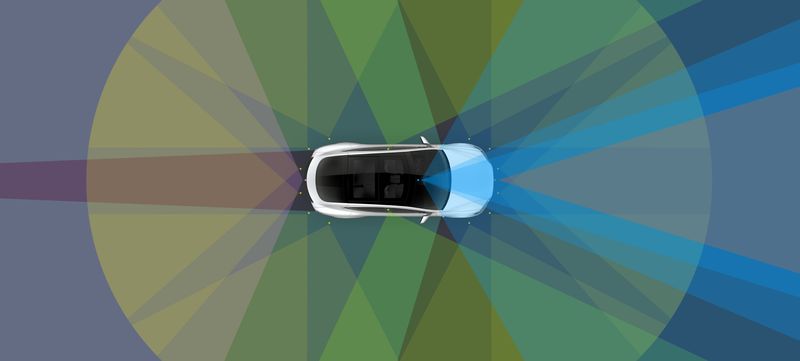Tesla is giving all its new cars the hardware for “full self-driving capabilities,” the company recently announced.
That would include the current Model S and Model X SUV, whose previous set of sensors Musk referred to as “Hardware 1”: one front-facing camera, 360-degree ultrasonic sensors, and front-facing radar.
The new equipment, to be know as “Hardware 2,” is comprised of eight cameras, 12 ultrasonic sensors, and a forward-facing radar system. This hardware configuration gives 360-degree viewing at up to 250 meters of distance.

The 12 ultrasonic sensors that can detect both hard and soft objects. The new forward-facing radar helps see through rain, fog, and dust.
The full autonomy update will be standard on all Tesla vehicles from here on out, Musk says.
The updates are included in all new Tesla vehicles built from today forward. Tesla says it needs to “further calibrate the system using millions of miles of real-world driving” before it hands your car fully over to a computer.
Musk started off the call with a testy answer – defending Tesla Autopilot and laying into media outlets that don’t put the accidents that have happened from it into the proper context. Autonomous driving is so much safer, Musk argues, that outlets that put too much emphasis on the crash are “killing people.” He then added: “next question.”
Musk says that the “Tesla Neural Net” doesn’t require any third party hardware sensors, and that it’s based on Nvidia Hardware and software with the core based on the super powerfull Titan GPU. He says that it’s 40 times more powerful than the last Tesla computer, “it’s basically a supercomputer in a car,” he said. “We go from one camera to eight cameras,” Musk said. Three of them are forward cameras, for redundancy, and the rest provide “360 coverage” for the rest of the car. The new Teslas will also have 360-ultrasonic sonar.
Combined with future versions of the so-called Autopilot software the company continues to develop, that suite of hardware will permit future Tesla vehicles to achieve “Level 5” autonomy.
The US NHTSA defines Level 5 autonomy as a vehicle not fitted with a steering wheel or any driver controls, one in which a passenger simply tells the car where to go—and then could, theoretically, go to sleep while the car travels there.
Musk said his goal would be for a self-driving Tesla vehicle to leave Los Angeles, take one or more occupants to New York City, and park there without any driver input, as soon as next year.
According to Musk, cars that could drive themselves could be coming soon, but if they were made this year, they’d almost certainly include a steering wheel and pedals, which would make them Level 4 cars.
Still, with the new suite of hardware, Musk said, “the foundation is laid.”
At some point in the future, Musk suggested, Tesla could offer two variants of each vehicle it sells: cars equipped with an enhanced version of the current Autopilot, and cars that can truly drive themselves.
Such future self-driving technology won’t be called Autopilot, he said, and will come with an $8,000 price tag to unlock on new vehicles.
Every car Tesla produces going forward will have the full autonomy hardware, Musk said.
